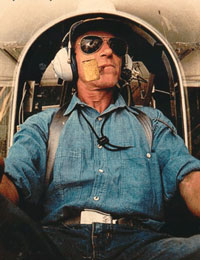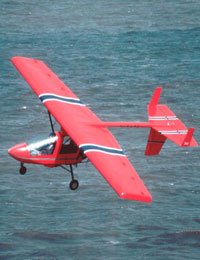While exploring the "Australian Hang Gliding History" site, I came across the "David Cook Aviator" section. I learned that David had built and flown
a Volmer Jensen VJ-23. I have always been interested to know how well this
aircraft flew, and what I found was very interesting. I also found that
David had added a small engine to the VJ-23, and had flown it across the
English Channel, a remarkable feat that was formally recognised. All of
this was leading David to build a more serious aircraft, with more
horsepower, enclosed cockpit and built for the job as a microlight, safe and
easy to fly. As I went through the general design concepts I found a strong
relationship with tried and true aircraft design, and not surprisingly a few
of the wrinkles to squeeze out some extra performance, eg., swept forward
wing, no dihedral, the wing plan view vaguely reminiscent of a Cessna 172
layout, all good practice, all very commendable. Then I was to discover in
the text that it did not have a definable stall, that it tended just to mush
without losing stability on any axis, didn't spin, and it achieved all of
this at speeds at or below 25 miles per hour, and when the stick was pushed
forward it immediately regained normal flight. My curiosity was now aroused
way above normal, and I just had to find out what airfoil David had used. I
made some guess's and expected an airfoil section that would be commonly
used at speeds below 100mph. I thought perhaps a Clark Y or a Naca 4411. I
was wrong. I was amazed to find that David had developed the airfoil
himself, following some study to airfoil reference books. In a piece that
he had written for a magazine, he inferred he developed a fairly normal 30%
forward section of the airfoil, and then just drew a straight line from the
top surface to the trailing edge, and similar treatment on the bottom
surface. I have seen something like this before with Benson B-7 and B-8
Gyrocopter rotor blades. I found in the photos within the website a picture
of several "Shadows", a side view of the airfoil where the wing connects to
the centre section of the structure. I compared this shape with dozens of
others and found it to be most like helicopter rotor blade airfoils. To me
this is an astounding finding. The shape of David's airfoil is unique in its
use in a fixed wing aircraft. That it was untested in a wind tunnel, and
simply built onto the aircraft and flown is remarkable. I conclude that it
is the case sometimes, that some people, and David is one of them, have an
instinctive genius when they know something is right. His aircraft, with
its amazing airfoil, has a most enviable record, in that there has never
been a fatality, although 450 examples have been built and flown, many of
them with low time amateur pilots.
David's Shadow is a most remarkable
aircraft.
John W. Dickenson.

